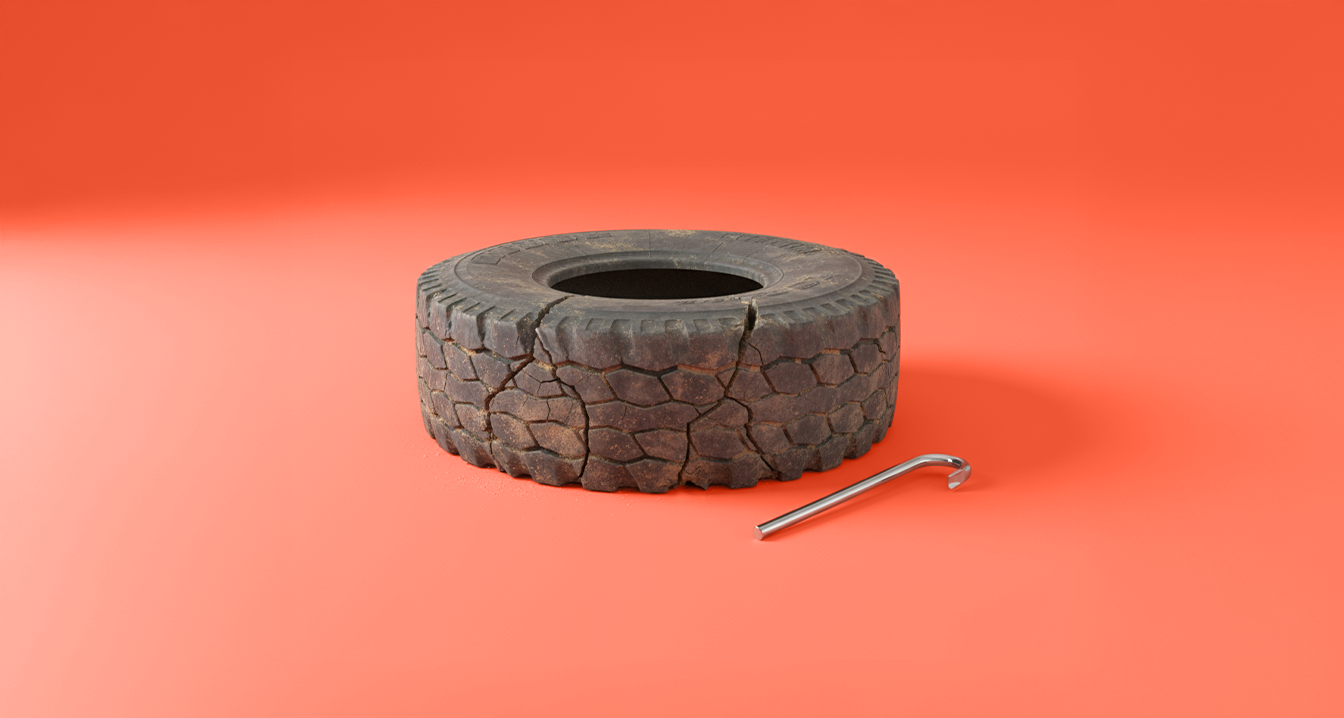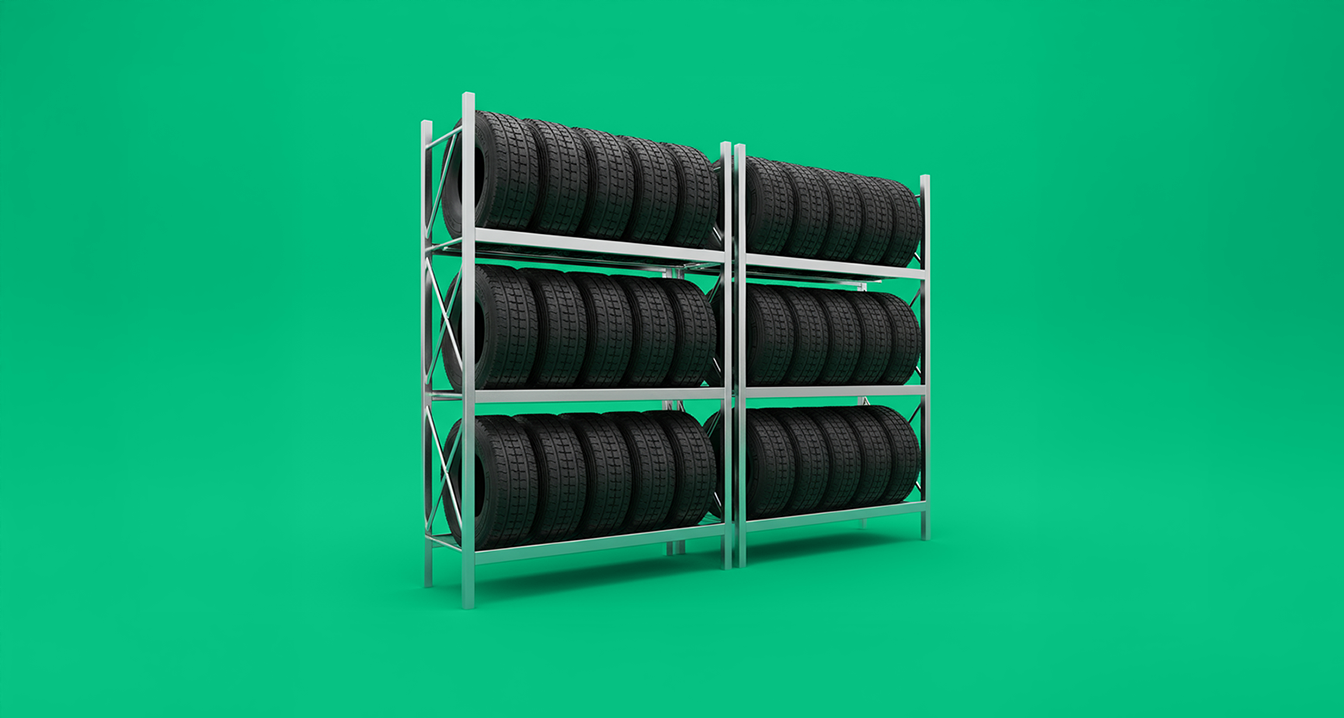At first glance, the process of changing tires seems very routine, but it requires engineering accuracy in handling and fastening, especially with large truck tires. These tires are the rotating rings in the commercial transport sector, which in turn revives the local and international economy. Any mistake in the installation process can turn a safe journey into a serious tragic nightmare. The American Highway Safety Organization has conducted a study on fatal accidents and found that 15% of accidents are related to mechanical problems and errors, foremost among which is the incorrect installation of tires.
Failure to tighten tires after changing them is one of the problems that contribute to an increase in accidents and side stops on commercial roads. After we have overcome tragic accidents, there is a clear impact on performance. The performance of tires is largely linked to the way they are installed and distributed. Therefore, the installation process is a safety lock placed on tires to protect and ensure the safety of commercial roads. The function of fastening nuts focuses on controlling the torque pressure that pulls tires out with a high intensity.
Risks caused by a lack of tight tires

First: the separation of the wheel and the tire while driving
When the craftsman fails to tighten the wheel screws with the appropriate torque with the torque device (Torque), the screws face a great challenge in resisting the intense and continuous vibration forces throughout the movement of the truck with different terrains and environments on the road. As time passes and the truck travels for long distances for days and months, vibrations can weaken the grip between the wheel and the axis of rotation called (Hub). In many cases, strong disturbances and loss of control occur, but in severe cases or in which the screws are missing or very loose, the wheel separates from the truck, causing a real disaster on the roads fast.
The serious consequences begin to appear immediately if the wheel and the tire are separated. The driver loses control of the vehicle. If one front tire is lost, the truck will deviate significantly from its course, while if one rear tire is lost, the truck will lose its ability to balance. The matter is more severe in the case of trucks and rear-wheel drive cars. On the other hand, the flying wheel causes serial accidents and may crash into other vehicles causing a series of accidents and stops as well as injuries to pedestrians or public and private property on the road. This is so dangerous that it makes us look like a separate wheel The truck has a rubber shell that, if it hits the infrastructure, may cause significant damage to it. This makes us note the importance of fixing the wheels tightly and making sure of this before each trip in order to remove any doubt. This is a precautionary measure that ensures the safety of all.
In 2018, the Traffic Safety Administration in the United States of America (NHTSA) recorded 35 fatal accidents caused by sudden wheel separation. Most of the cases were due to improper installation of wheels and tires. One such accident occurred in Texas when a wheel broke off from a transport truck, resulting in a collision with a family car and causing the death of three people.
Second: vibrations and dynamic instability
It should be noted that the risk of not installing the wheels correctly is not limited to the separation of the wheel, but even more so even if the tire does not separate completely. The first is the occurrence of continuous vibrations that cause the driver to lose dynamic stability in straight tracks. These vibrations are transmitted to the truck body through the suspension system. The damage spreads from the tires to the rim and then reaches the blackberry system and the whole truck. This results in a series of bad consequences for vehicles. In the case of buses and personnel trucks, this causes significant and terrible discomfort to passengers, while The matter gets worse when we talk about commercial transport trucks. Here you are talking about goods and commercial materials that cost twice the price of the whole truck. Being exposed to severe vibration and confusion exposes them to damage and breakage. This damages the secretariats and thus reduces the level of trust in the truck driver and the logistics company responsible for this truck.
One of the accumulated damages that result over time if the problem is not fixed is that which affects wheel bearings, which are damaged more quickly than usual in the event of vibrations and loss of stability, making maintenance costs double on a monthly basis, while the impact on wheel rims is visible through cracks and fungus on the wheel structure, especially in aluminum alloy wheels, which are more susceptible to metal stress and are therefore more susceptible to disintegration and cracking. These problems are all directly reflected in the structure of truck tires, leaving irregular wear and swelling in the tire walls, which accelerates the expiration of its useful life, It again increases regular maintenance costs.
Third: increased fuel consumption
The impact of tires that are not firmly fixed focuses on an abnormal increase in fuel consumption due to the imbalance that occurs throughout the vehicle, which is one of the causes of increased engine load, in addition to increased tire friction on the road, forcing the engine to make a double effort and burn more fuel to maintain the required speed. Increased fuel consumption in trucks is a serial problem, meaning that it does not end at a certain point but continues to cause damage to the rest of the internal and external parts of the engine. One of the first parts affected is the suspension and braking systems, followed by the internal parts of the engine, which makes us We move from a simple problem related to wheel bolts to comprehensive engine maintenance.
additional information: Many people may ask why increased tire friction affects fuel consumption. The answer to this can be simplified by saying that the area of friction occupied by tires increases, the more force they need to move. If we want to elaborate more in the answer, we can say that the area in contact with the ground requires a certain force to get out of the state of rest to the state of motion. Each centimeter of this area has the corresponding Newtonian force (torque) issued by the engine. When the tires are unstable or under pressure, the area in contact with the tire increases, which increases the need for the kinetic force that sounds The engine turned it on, and this This puts the engine in front of an additional challenge, making it more fuel-consuming than if the space is normal and does not constitute a significant load on the engine.
Fourth: unexpected failures!
Suspension damage:
When tires are installed in the wrong way, unbalanced or with an inappropriate torque, these errors result in high vibrations transmitted from the wheels directly to the rear and front joints in truck suspension systems, causing a buildup of dynamic pressure on springs and hydraulic valves that were not designed to withstand them, while on the other hand, damage is caused to ball joints or so-called (Ball Joints), which are literally the joints of the suspension system, through which vibrations reach the upper control arm (Upper Control Arm) when these parts begin to lose their ability to absorb high pressure and withstand curves Turning is correct and smooth. You may even hear sounds and clicking from them. This indicates damage to these important parts. Only the truck and the car drive. These parts are intact, which means increasing the downtime for maintenance and repair, causing an economic and financial problem for the driver and logistics companies.
Brake system damage:
As a result of the wrong installation of tires, or if the nuts are not tightened, all these factors affect the rotor carrier (Rotor Carrier), causing a certain deviation in different degrees. This change results in a greater change in the thickness of the brake disc (Rotor Runout), causing vibrations when the brake pedal is pressed. These continuous vibrations force the brake pads to make an unbalanced contact with the rotor, exposing certain areas of it to greater pressure and temperature than the allowed limit. This causes uneven wear of the brake discs, resulting in creaking and rattling. If this problem is ignored, the rotor may bend due to excessive pressure High temperatures, all of which significantly increase the expected stopping area, exposing the vehicle to serious danger if the driver wants to brake at a high speed.
It is clear to the reader that there is a risk of damage to the brake system, especially in commercial trucks that use highways. Increased stopping time means that the truck may not stop in the right place and time, and may crash in front of it before the driver can make any useful reaction. These risks to the driver community must cooperate to solve and avoid them by raising awareness and adherence to safety and security rules.
The tire pressure monitoring system (TPMS) has failed:
The tire pressure monitoring system, known as (TPMS), includes accurate internal sensors installed in the wheel ribs or in the internal air valve of the tires. The efficiency of the system depends on the correct installation of tires and without the valve being touched by any screwdriver or other tools. Care should be taken that the valve is hit directly during installation or during the maintenance phase, and in other cases when the tires are installed incorrectly and the nuts are not well tightened due to the use of traditional tools to remove and install wheels that require axial force, which increases the possibility of injury. The sensor may be exposed to A scratch or fine fracture in the sensor body, causing a slow leak in the pressure inside the tires without alerting the electronic system and the sensor cannot detect it due to damage.
In addition, the internal battery of the sensor may fail due to damage to the moisture-proof cover due to the changing pressure of the tires. At that time, the system issues false alarms and alerts or stops working completely, making the driver unable to know the tire pressure. This means that the warning is interrupted for any drop in pressure that may allow the driver to avoid a disaster, which increases the level of danger to the driver and his teammates on the road, as well as excessive tire friction, causing damage and explosion. When a slow leak occurs without monitoring, a side bump or a flat impression called (Flat Spot) may appear on the tires due to the use of tires It is partially filled with air, gradually increasing waste in performance, reducing the required tire life and speeding up early replacement.
Misreading the speedometer:
When the tire size changes due to air leakage, the installation of tires of a different size than the appropriate size for the truck, or if the tire is significantly damaged and worn, the truck's speed measurement system is partially disrupted. The speedometer depends on the number of revolutions of the tire, which has changed its outer diameter due to damage and wear, creating a reading error of 3-5% in the actual reading of speed and distance traveled. This noticeable imbalance makes the driver go faster or lower than the specified road speeds, exposing him to risks and violations. All these problems are directly related to the method of installing and tightening the wheels, because as we said before, tires are an influential part of All parts of the vehicle.
In addition to what we mentioned above, the significant difference in the tire diameter causes a change in the weight distribution on the suspension systems, which steer the truck and distribute the driving force, which increases the intensity of vibrations and reduces the accuracy of the response of the electronic stability control system (ESC), in addition to other auxiliary systems.
Neglecting to install tires properly does not only mean the possibility of wheel separation while driving, but also opens the door to a series of serious faults, starting with loss of control of the vehicle, vibrations that damage suspension and braking systems, and end only with increased fuel consumption, tire wear and sensor damage... All of this is due to Bragg who did not have the proper resolve.
How to avoid these issues:
The installation and maintenance of tires is one of the most important factors related to safety on commercial roads. Failure to install nuts tightly and in the correct way leads to serious accidents. Improper use of tools or negligence in periodic inspection increases the expected risks during long trips. In the next lines, we will talk in depth about how to avoid these problems:
First: the correct way to tighten the nuts
Adjusting the tightening torque accurately maintains balanced contact between the wheel and the axle, preventing wheel deflection or separation while driving. If the nuts are not tight enough, the wheel may lose its secure stability, as if tightened with a high force, the wheel bolts may expand or break. Next are the practical steps to tighten the nuts.
Practical steps to adjust the correct tightening torque:
a. Cleaning and preparing the wheels: Make sure that the screws, nuts and wheel hub, especially the wheel holes, are clean from rust and dirt, because the presence of dirt in these areas prevents full contact, which means poor handling of the metal expansion process with heat.
b. The sequence of cross-linking: ride the wheel on the axle and then tighten the nuts in a cross (star) initially with your hand only until there is full contact between the nuts and the wheel surface. This method ensures a better distribution of the weight of the wheels and greater stability.
c. Using a calibrated torque wrench: Using a calibrated torque device known as (Torque Wrench), which is adjusted to the appropriate value to tighten the nuts according to the manufacturer's recommendations, complete the tightening of the nuts to reach the specified torque. Certainly, the nuts are tightened in two stages. At each stage, half the torque is compressed as a safer measure to avoid causing deformation or excessive stress on the device and nuts.
d. Final verification: After completing the operation as required, review the steps and check the torque key reading meter to make sure that the operation was completely successful and without errors.
What are the risks of neglecting this process?
As a result of tightening the nuts at less than the prescribed and correct value, the nuts will naturally relax and be subjected to severe pressure that may cause them to come out of the screws, thus separating the wheel completely. If this does not happen, the truck will be damaged in the parts connected to the tires, such as the braking systems and the suspension.
Second: quick inspection before launch
Even when the torque is adjusted to the right degree, nuts and bolts are subject to everything. Therefore, what they are exposed to is premature deviation due to the characteristics of the metal and its attempt to stabilize the new situation, as well as the vibration of the vehicle while loading goods and the rapid increase in pressure on the wheels. Therefore, experts always recommend driving the vehicle or truck for a short distance, and then a quick check of the nuts, wheels and tires, leading to a visual inspection of all the truck, in order to make sure that everything is fine before starting the long journey and staying on the specified track. This quick check gives the driver the ability to correct Before things become catastrophic, and before it is too late for the journey that was entrusted to him.
The practical steps for the quick check:
A- Complete driving the vehicle carefully during the first 100 kilometers, avoid entering long bridges or tunnels and then stop for a quick inspection.
b. In a suitable and secure situation, start by making sure to adjust the torque in all nuts by resetting them to the specified torque again.
c. Check that all nuts match the specified torque, because a difference in the torque of one nut indicates a problem with it.
d. Check the rest of the truck, such as tires, water, oil, and air, and make sure you're ready for the journey.
Tightening the nuts correctly using a torque wrench not only protects the tires, but also maintains the safety of the driver and the vehicle, and prevents accidents that may be catastrophic due to wheel separation while driving.
With these words, we have completed the precautionary and preventive procedures to ensure the safety of the vehicle, to ensure that there are no problems caused by the failure to tighten the wheel nuts, and to ensure the safety of the truck may expose you to situations that we do not wish for. This area dedicated to fixing tires is subject to many environments and changes. It is very easy for oxidation, rust, sagging, breakage and cracking. This is not strange for those who have had experience in this field.
Of course, Darbak Company Tires is working hard to provide awareness support to drivers and workers in the logistics sector through articles, publications and high-quality tires. While providing luxury products for the Saudi market, it has not skimped on information and knowledge and presented it on a plate of gold in this regard Knowledge library It is full of knowledge and information that feeds the knowledge of truck drivers and logistics fleet owners.
________________________________________
For more information on this topic:







